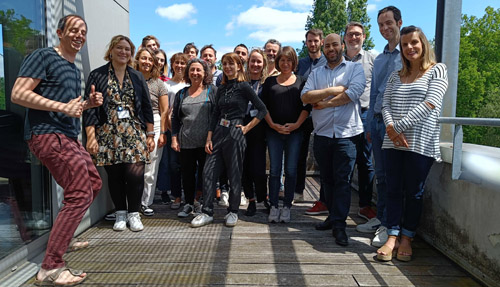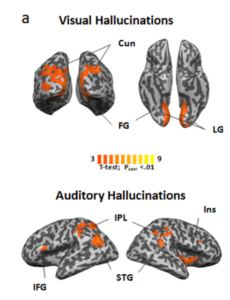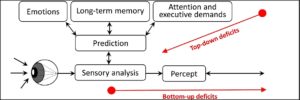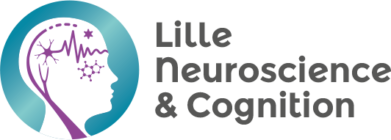Plasticity and SubjectivitY "PSY"

Presentation
The aim of our research is to determine the impaired mechanisms involved in subjective and intersubjective experiences as those observed in psychiatric conditions addictions, and more generally along a continuum ranging from normal to pathology. More specifically, we are interested in the pathophysiology of hallucinations, familiarity disorders, post-traumatic flashbacks, affective and cognitive biases, craving, suicidal ideas or body-schema illusions. This goal is notably achieved through the development of diagnosis tools that may help medical decision (e.g. for first-episode psychosis or after a suicide attempt), and the validation of non-pharmacological therapies for drug-resistant symptoms (e.g. neuroguided rTMS or fMRI-based neurofeedback for hallucinations, trauma-focused therapy). Finally, we are interested in how these subjective experiences can be affected by a stressful or protective environment, a dedicated treatment, etc. Such adaptations refer to what we call plasticity. To answer these different questions, we refer to experimental methods coming from the cognitive sciences, combined with advanced analyses of EEG/MRI signals and computational modeling. Our scientific projects are divided in four axes.
- STAFF
- RESEARCH INTEREST
- PUBLICATIONS
Principal Investigators
 | Pr. Renaud Jardri |
 | Dr. Delphine Pins I am particularly interested in exploring the neural mechanisms involved from visual sensation to visual awareness. My research focuses on normal and impaired access to consciousness of visual information, using behavioral and functional brain imaging approaches. I am particularly interested in hallucinations and familiarity disorders in schizophrenia. |
 | Pr. Pierre thomas Full Professor (Psychiatry) |
 | Pr. Guillaume Vaiva Full Professor (Psychiatry) |
 | Pr. Olivier Cottencin Research theme: study of factors of protection and vulnerability to the initiation and self-maintenance of addictive behaviors - Cognitive and emotional biases in patients with addictions to psychoactive substances and in patients with eating disorders - Fate studies and therapeutic trials |
 | Dr. Ali Amad |
 | Dr. Fabien D’Hondt University of Lille, Faculty of Medicine. Teaching: Cognitive & affective neurosciences, Psychiatry and Addictology. Research: Behavioral and cerebral correlates of cognitive (attention and executive functions) and affective (emotion and social cognition) disorders in psychiatry (post-traumatic stress disorder) and addictology (alcohol use disorders) |
| |
 | Dr. Thomas Fovet, MD, PhD Currently in charge of research projects at the National Resource and Resilience Center of Lille (CN2R), I am a psychiatrist in the Psychiatry, Forensic Medicine and Prison Medicine pole of the Lille University Hospital. I am mainly interested in forensic psychiatry and in particular in psychiatric disorders in prison settings but also in innovative therapeutic approaches such as neurofeedback. " |
 | Dr. Pierre Grandgenèvre, MD, PhD |
 | Dr. Dewi Guardia , MD, PhD |
 | Dr. Mathilde Horn, MD, PhD |
 | Dr. Charles-Edouard Notredame, MD, PhD |
 | Dr. Arnaud Leroy, MD, PhD My research topics are the study of intrusive experiences (schizophrenia and post-traumatic stress disorder) and psychogenic non-epileptic seizures, with the study of their neuronal correlate by MRI (functional, effective and spectro-MRI connectivity), and the use of neuromodulation treatments in these indications.
|
 | Dr. Dominique Servant, MD, PhD |
| |
 | Charlotte Caillot In charge of the PrediPsy project supported by ARS HdF and F2RSM Psy with a dual objective. First, to facilitate access to brain MRI in patients with a first psychotic episode in the Hauts-de-France region and to develop future tools for predicting the first psychotic episode. I also have more transversal missions within the team. |
 | David Roman Trained as a psychologist specializing in clinical neuropsychology and also providing clinical research attaché missions, support for imaging projects for psychotic disorders (hallucinations, first psychotic episode) within the team since 2015. |
 | Sébastien Szaffarczyk Engineer |
| |
 | Vincent Bouttier |
 | Coralie Creupelandt Project: Visuo-perceptual deficits in Severe Alcohol Use Disorder: Behavioral characterization and implications for the decoding of emotions. This project studies the interactions between vision and emotions in people with severe alcohol use disorder (ASD), with a dual objective: (i) to determine whether the affective deficits observed in this population can be due, at least in part, to low level visual deficits; (ii) test, in a clinical population, the validity of the "affective prediction" model which offers a completely new perspective on vision-emotion interactions, by considering that these systems maintain close and early relationships in the continuum of cognitive processing . Thesis supervisors: Dr Fabien D'Hondt and Dr Pierre Maurage, Louvain Experimental Psychopathology research group (LEP) of UC Louvain |
 | Alice Demesmaeker Project: Longitudinal epidemiology and pharmaco-epidemiology in psychiatry. My research project aims to assess morbidity and mortality in patients suffering from psychiatric disorders, in particular with the identification of risk factors for suicidal recurrence and death by suicide. Thesis supervisor : Dr Ali Amad |
 | Candela Donantueno |
 | Nadia Guerouaou Project: Use of an emotional vocal feedback technique as part of the therapy of exposure in imagination to the traumatic event in PTSD (Post Traumatic Stress Disorder). " My thesis work focuses on the voice of patients with PTSD, particularly during imaginary re-exposure therapy to the event. Thesis supervisors: Pr Guillaume Vaiva and Dr Jean-Julien Aucouturier between Lille (CRP HdF, CHRU Lille) and Paris (IRCAM) |
 | Salomé Leclercq Project: Neurophysiological basis of Circular Inference. This thesis work aims to clarify the mechanisms of the genesis and maintenance of perceptions and beliefs in the general, sub-clinical and clinical population. We will use probabilistic behavioral tasks, tools from neuropsychology and psychiatry, as well as physiological recordings. Thesis supervisor : Pr Renaud Jardri |
 | Louise Loisel-Fleuriot Project: Neurovegetative and subjective correlates of affective forecasting skills in post-traumatic stress disorder (PTSD) This project will provide data on the affective forecasting capacities of patients with PTSD, with the ultimate goal of optimizing the clinical improvement of patients during their therapeutic support. Keywords: emotion; post-traumatic stress disorder; affective anticipation; virtual reality ; vegetative system Thesis supervisor : Dr Fabien D'Hondt |
 | Emilie Veerapa |
Alumni
- Aurély Ameller : MD, PhD
- Morgane Demeulemeester : PhD
- Anne-Claire Leterme
- Victoire Benard

Axe 2. Familiarity & Social Interactions
Sense of familiarity is a crucial aspect of recognition because it provides the experience that an item, a person, has been previously encountered, independently of its identity or of any recollection of the associated details. This ability is essential to establish appropriate social interactions. Our recent work highlighted the importance of affective processes in familiarity access, particularly for specific familiarity (e.g. family, friends, personally known streets, places, own objects...). In this axis, we examine the mechanisms and neural correlates of perceptual, affective and cognitive processes involved in familiarity feeling. Moreover, to better circumscribe the impact of familiarity disorders on social interactions, we use a transdiagnostic approach, in disorders known to impact social interactions such as schizophrenia, alcohol dependence, depersonalization, autism-spectrum disorders... A second line of research focuses on early social interactions. This project is more particularly developed through the study of the relationship between post-partum depression (PPD) and mother-baby interactions. Indeed, PPD impacts mother-baby interactions and tuning abilities, which can result in mother-child bonding impairments. Maternal behavior is one aspect of social skills for which regulation by oxytocin (OTX) is particularly documented. The main aim of this second project is to test whether we can improve mother-baby interactions in mothers at-risk for PPD using intranasal OTX. Meta-analysis showing functional maps of the brain network activated during familiar faces presentation (from Horn et al., Cogn Affect Behav Neurosci 2016).
Meta-analysis showing functional maps of the brain network activated during familiar faces presentation (from Horn et al., Cogn Affect Behav Neurosci 2016).
Axe 3. Brain plasticity
Brain plasticity, defined as the ability of the nervous system to adapt to environmental demands, is crucial to the brain functioning and to its homeostasis. We use severe mental illness to study different aspects of brain plasticity. The first topic of this research axis is dedicated to the development of an objective psychiatry using computer science methods. The second topic focuses on a multi-scale approach to the environment (i.e. "everything different from the gene") in psychiatric disorders (genetics, imaging and epidemiology). Several projects are developed in this field, such as the epidemiology of environmental factors in severe mental illness, the multi-scale approach to physical treatments (neuromodulation) such as transcranial magnetic stimulation and electro-convulsive therapy, and pharmacogenetics coupled with imaging in the prediction of response to treatment. Finally, the last topic focuses on the recently developed concept of plastic adaptation to pathology, highlighting the bidirectional nature of the neuroplastic modifications associated with the longitudinal evolution of psychiatric disorders, particularly in the light of the concepts of brain economy.Axe 4. Affective Predictions
Processing the affective value of sensory information is an essential part of individuals' interactions with their environment. Impairment of this skill is a central component of many disorders in psychiatry and addiction. This line of research is therefore interested in the neurocognitive mechanisms underlying the reaction to or anticipation of affective stimuli using neuroscience (EEG, eye-tracking, electrodermal response…) and experimental psychology (visual stimuli and hearing, virtual reality...) methods. Our current work focuses more specifically on the perception of emotional and social signals and the allocation of attentional resources to these stimuli in alcohol use disorders and post-traumatic stress disorder. It also aims to offer new therapies dedicated to the management of these affective disorders. Illustration of the integrated model proposed in the context of severe alcohol use disorders. The model postulates that the difficulties of patients in visual perception are the result of the combination of bottom-up and top-down deficits, the latter being the cause of inappropriate predictions, including on the affective content of stimuli, early in sensory processing (adapted from Creupelandt et al., 2019).
Illustration of the integrated model proposed in the context of severe alcohol use disorders. The model postulates that the difficulties of patients in visual perception are the result of the combination of bottom-up and top-down deficits, the latter being the cause of inappropriate predictions, including on the affective content of stimuli, early in sensory processing (adapted from Creupelandt et al., 2019).
Selected Publications
Axe 1. Hallucinations & Illusions
Humpston C, Garrison J, Orlov N, Aleman A, Jardri R, Fernyhough C & al, Real-Time Functional Magnetic Resonance Imaging Neurofeedback for the Relief of Distressing Auditory-Verbal Hallucinations: Methodological and Empirical Advances. Schizophr Bull, 2020.
Cachia A, Cury C, Brunelin J, Plaze M, Delmaire C, Oppenheim C & al , Deviations in early hippocampus development contribute to visual hallucinations in schizophrenia. Transl Psychiatry, 2020.
De Pierrefeu A, Fovet T, Hadj-Selem F, Lofstedt T, Ciuciu P, Lefebvre S & al , Prediction of activation patterns preceding hallucinations in patients with schizophrenia using machine learning with structured sparsity. Hum Brain Mapp, 2018.
Leroy A, Foucher JR, Pins D, Delmaire C, Thomas P, Roser MM & al , fMRI Capture of Auditory Hallucinations: Validation of the Two-Steps Method, Hum Brain Mapp, 2017.
Jardri R, Duverne S, Litvinova AS, Denève S , Experimental evidence for circular inference in schizophrenia, Nat Commun, 2017.
Axe 2. Familiarity & Social Interactions
Ameller A, Picard A, D'Hondt F, Vaiva G, Thomas P, Pins D , Implicit Recognition of Familiar and Unfamiliar Faces in Schizophrenia: A Study of the Skin Conductance Response in Familiarity Disorders. Front Psychiatry, 2017.
Horn M, D'Hondt F, Gharib A, Gangloff L, Dumais A, Amad A & al , Association between familiarity disorders and serious violence among inmates with schizophrenia. Schizophr Res, 2017.
Horn M, Jardri R, D’Hondt F, Vaiva G, Thomas P, Pins D, The multiple neural networks of familiarity: a meta-analysis of functional imaging studies. Cogn Affect Behav Neurosci, 2016.
Horn M, D’Hondt F, Vaiva G, Thomas P, Pins D, Categorical perception of familiarity: evidence for a hyper-familiarity in schizophrenia. J Psychiatr Res, 2015.
Ameler A, Dereux A, Dubertret C, Vaiva G, Thomas P, Pins D, ‘What is more familiar than I?’ Self, other and familiarity in schizophrenia. Schizophr Res, 2015.
Axe 3. Brain plasticity
Amad A, Jardri R, Rousseau C, Larochelle Y, Ioannidis JPA, Naudet F , Excess Significance Bias in Repetitive Transcranial Magnetic Stimulation Literature for Neuropsychiatric Disorders. Psychother Psychosom, 2019.
Amad A, Expert P, Lord LD, Fovet T, Geoffroy PA , Plastic Adaptation to Pathology in Psychiatry: Are Patients with Psychiatric Disorders Pathological Experts? Neuroscientist, 2019.
Amad A, Radua J, Vaiva G, Williams S, Fovet T , Similarities between Borderline Personality Disorder and Post traumatic Stress Disorder: evidence from Resting-State Meta-Analysis. Neurosci Biobehav Rev, 2019.
Amad A, Ramoz N, Peyre H, Thomas P, Gorwood P , FKBP5 gene variants and borderline personality disorder. J Affect Disord, 2019.
Amad A, Seidman J, Draper SB, Bruchhage MMK, Lowry RG, Wheeler J & al , Motor Learning Induces Plasticity in the Resting Brain-Drumming Up a Connection, Cortex, 2017.
Axe 4. Affective Predictions
Creupelandt, C., D'Hondt, F., & Maurage, P. (sous presse). Neural correlates of visuoperceptive impairments in severe alcohol use disorders. Journal of Neuroscience Research.
Creupelandt, C., Maurage, P., Lenoble, Q., Lambot, C., Geus, C., & D'Hondt, F. (sous presse). Magnocellular and parvocellular mediated luminance contrast discrimination in Severe Alcohol Use Disorder. Alcoholism: Clinical and Experimental Research.
Bollen, Z., Masson, N., Salvaggio, S., D’Hondt, F., & Maurage, P. (2020). Craving is everything: An eye-tracking exploration of attentional bias in binge drinking. Journal of Psychopharmacology, 34(6), 636–647.
Veerapa, E., Grandgenevre, P., El Fayoumi, M., Vinnac, B., Haelewyn, O., Szaffarczyk, S., Vaiva, G., & D'Hondt, F. (2020) Attentional bias towards negative stimuli in healthy individuals and the effects of trait anxiety. Scientific Reports, 10, 1–10.
Maurage, P., Masson, N., Bollen, Z., & D’Hondt, F. (2020). Eye tracking correlates of acute alcohol consumption: A systematic and critical review. Neuroscience & Biobehavioral Reviews, 108, 400 422.
